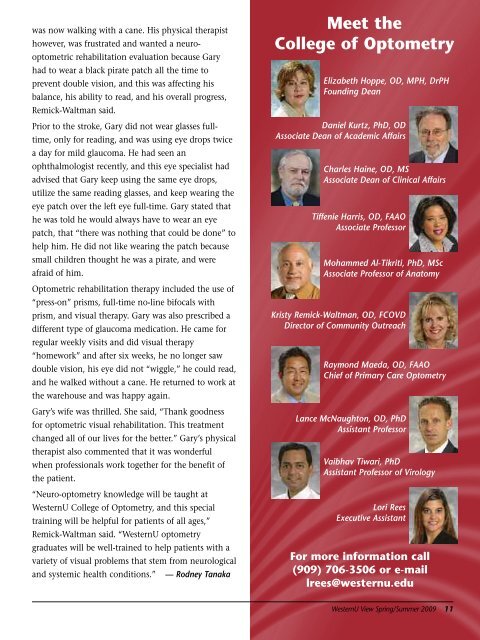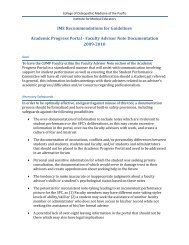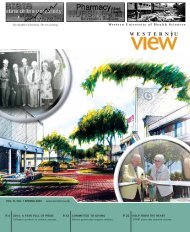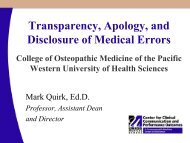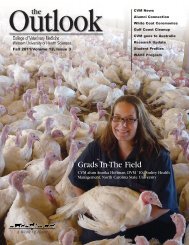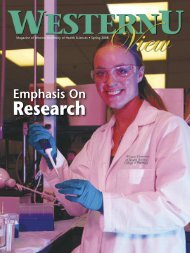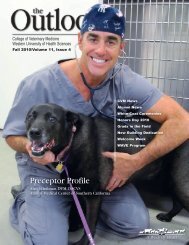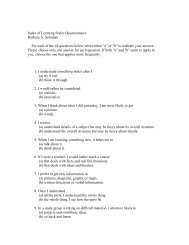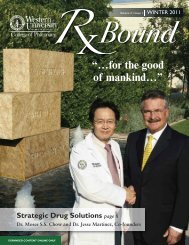EDUCATION - Western University of Health Sciences
EDUCATION - Western University of Health Sciences
EDUCATION - Western University of Health Sciences
- No tags were found...
Create successful ePaper yourself
Turn your PDF publications into a flip-book with our unique Google optimized e-Paper software.
was now walking with a cane. His physical therapisthowever, was frustrated and wanted a neurooptometricrehabilitation evaluation because Garyhad to wear a black pirate patch all the time toprevent double vision, and this was affecting hisbalance, his ability to read, and his overall progress,Remick-Waltman said.Prior to the stroke, Gary did not wear glasses fulltime,only for reading, and was using eye drops twicea day for mild glaucoma. He had seen anophthalmologist recently, and this eye specialist hadadvised that Gary keep using the same eye drops,utilize the same reading glasses, and keep wearing theeye patch over the left eye full-time. Gary stated thathe was told he would always have to wear an eyepatch, that “there was nothing that could be done” tohelp him. He did not like wearing the patch becausesmall children thought he was a pirate, and wereafraid <strong>of</strong> him.Optometric rehabilitation therapy included the use <strong>of</strong>“press-on” prisms, full-time no-line bifocals withprism, and visual therapy. Gary was also prescribed adifferent type <strong>of</strong> glaucoma medication. He came forregular weekly visits and did visual therapy“homework” and after six weeks, he no longer sawdouble vision, his eye did not “wiggle,” he could read,and he walked without a cane. He returned to work atthe warehouse and was happy again.Gary’s wife was thrilled. She said, “Thank goodnessfor optometric visual rehabilitation. This treatmentchanged all <strong>of</strong> our lives for the better.” Gary’s physicaltherapist also commented that it was wonderfulwhen pr<strong>of</strong>essionals work together for the benefit <strong>of</strong>the patient.“Neuro-optometry knowledge will be taught at<strong>Western</strong>U College <strong>of</strong> Optometry, and this specialtraining will be helpful for patients <strong>of</strong> all ages,”Remick-Waltman said. “<strong>Western</strong>U optometrygraduates will be well-trained to help patients with avariety <strong>of</strong> visual problems that stem from neurologicaland systemic health conditions.” — Rodney TanakaMeet theCollege <strong>of</strong> OptometryElizabeth Hoppe, OD, MPH, DrPHFounding DeanDaniel Kurtz, PhD, ODAssociate Dean <strong>of</strong> Academic AffairsCharles Haine, OD, MSAssociate Dean <strong>of</strong> Clinical AffairsTiffenie Harris, OD, FAAOAssociate Pr<strong>of</strong>essorMohammed Al-Tikriti, PhD, MScAssociate Pr<strong>of</strong>essor <strong>of</strong> AnatomyKristy Remick-Waltman, OD, FCOVDDirector <strong>of</strong> Community OutreachRaymond Maeda, OD, FAAOChief <strong>of</strong> Primary Care OptometryLance McNaughton, OD, PhDAssistant Pr<strong>of</strong>essorVaibhav Tiwari, PhDAssistant Pr<strong>of</strong>essor <strong>of</strong> VirologyLori ReesExecutive AssistantFor more information call(909) 706-3506 or e-maillrees@westernu.edu<strong>Western</strong>U View Spring/Summer 2009 11


